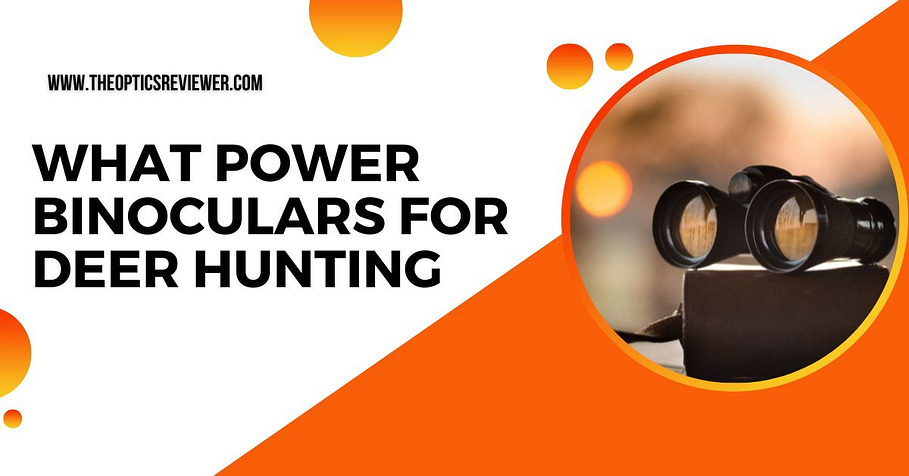When it comes to choosing what power binoculars for deer hunting, there are several factors to consider that can significantly impact your hunting experience. Understanding the appropriate power range can make a substantial difference in your ability to spot and track deer effectively.
With a vast array of options available, selecting the ideal power binoculars tailored to your hunting needs is crucial. Stay tuned to uncover the key insights that will help you make an informed decision for your next hunting expedition.
Contents
- 1 Key Takeaways
- 2 What are the Key Features to Look For in Binoculars For Deer Hunting?
- 3 What Power Binoculars For Deer Hunting?
- 4 What is the Ideal Objective Lens Size For Binoculars For Deer Hunting?
- 5 What is the Difference Between High Power and Low Power Binoculars for Deer Hunting?
- 6 What are the Uses of Hunting Binoculars?
- 7 Conclusion
- 8 References
- 9 Frequently Asked Questions
- 9.1 Can Binoculars Be Used for Hunting Any Other Animals Besides Deer?
- 9.2 How Do I Properly Clean and Maintain My Hunting Binoculars?
- 9.3 Are There Specific Features to Look for in Binoculars for Hunting in Different Terrain?
- 9.4 Can Binoculars Help With Identifying Animal Tracks or Other Signs of Game?
- 9.5 What Is the Best Way to Calibrate Binoculars for Optimal Performance During Deer Hunting?
Key Takeaways
- Opt for 8x to 10x magnification for optimal deer hunting performance.
- Consider reputable brands like Nikon, Vortex, Leupold, and Bushnell.
- Prioritize rugged, weather-resistant, and lightweight binoculars for hunting durability.
- Choose wide field of view, fully multi-coated lenses, and adequate eye relief for efficient deer spotting.
What are the Key Features to Look For in Binoculars For Deer Hunting?
When selecting binoculars for deer hunting, it is essential to prioritize features such as magnification power, lens diameter, and optical quality to ensure optimal performance in the field. Lens coatings play a crucial role in enhancing image quality by reducing glare and improving light transmission. Look for binoculars with fully multi-coated lenses for the best results. A wide field of view is beneficial for tracking fast-moving deer across different terrains. Opt for binoculars with a wide field of view to maintain situational awareness.
Additionally, adequate eye relief is vital for comfortable extended use, especially for eyeglass wearers. Waterproof design is a must-have feature to withstand various weather conditions and ensure durability in the field. Lastly, consider binoculars with tripod adaptability for extended viewing periods, reducing hand fatigue, and providing stable images for long-range observations. Prioritizing these key features will enhance your deer hunting experience and improve your overall success in the field.

What Power Binoculars For Deer Hunting?
Selecting the appropriate power binoculars is crucial for optimizing your deer hunting experience. When choosing binoculars for deer hunting, consider the magnification options, best brands, durability factor, weather resistance, and weight considerations. The magnification power of binoculars is a key factor to consider. Opt for magnifications ranging from 8x to 10x for deer hunting, as they provide a good balance between zoom level and stability. Some of the best brands known for producing high-quality binoculars for hunting include Nikon, Vortex, Leupold, and Bushnell. These brands offer a range of options with excellent optics and durability.
When it comes to durability, look for binoculars with a rugged construction that can withstand the rigors of hunting expeditions. Additionally, opt for models with weather resistance to ensure they perform well in various outdoor conditions. Weight considerations are also important, as you’ll likely be carrying the binoculars for extended periods. Choose a lightweight yet sturdy pair that won’t weigh you down during long hunting trips.
| Consideration | Description | Example Choices |
|---|---|---|
| Magnification Options | Opt for 8x to 10x magnification for deer hunting | 8×42, 10×50 |
| Best Brands | Nikon, Vortex, Leupold, Bushnell | Nikon Monarch 5, Vortex Diamondback |
| Durability Factor | Rugged construction for durability | Leupold BX-4 Pro Guide, Bushnell Trophy XLT |
| Weather Resistance | Waterproof and fog-proof features for all-weather use | Vortex Diamondback HD, Nikon Prostaff 3S |

What is the Ideal Objective Lens Size For Binoculars For Deer Hunting?
For an optimal deer hunting experience, one crucial aspect to consider is determining the ideal objective lens size for binoculars. The objective lens size plays a significant role in the performance of binoculars, affecting factors such as image clarity, low light performance, and overall usability in the field.
- Lens Diameter, Magnification: The lens diameter influences how much light enters the binoculars, impacting image brightness and clarity. Smaller lenses are lighter but may sacrifice image quality, while larger lenses provide better light transmission and clarity, especially in low light conditions.
- Lens Coating, Field of View: Lens coatings reduce glare and improve light transmission, contributing to better image quality. A wider field of view allows you to observe more of your surroundings, making it easier to spot deer.
- Eye Relief, Durability: Sufficient eye relief is essential for comfortable extended use. Durable construction ensures longevity, even in rugged hunting environments.
- Weather Resistance, Weight: Weather-resistant binoculars can withstand harsh conditions, while lightweight models are easier to carry for extended periods in the field. Select a balance between durability and weight that suits your hunting style.
If interested you can read more about are binoculars allowed at concerts.
What is the Difference Between High Power and Low Power Binoculars for Deer Hunting?
In the realm of deer hunting optics, distinguishing between high power and low power binoculars is pivotal for enhancing your viewing capabilities in the field. High power binoculars typically have magnification levels above 10x, providing detailed views of distant targets but potentially sacrificing field of view and stability. On the other hand, low power binoculars usually offer magnifications below 8x, allowing for wider fields of view and better stability, making them suitable for scanning large areas quickly.
When it comes to optical quality, high power binoculars may exhibit more pronounced image shake due to the higher magnification, requiring steady hands or additional stabilization. Conversely, low power binoculars tend to be more forgiving of small movements, making them easier to use for extended periods without causing eye strain. Ultimately, the choice between high power and low power binoculars for deer hunting depends on individual preferences, hunting conditions, and the specific requirements of your hunting environment.
If interested you can read more about Are Binoculars Allowed on Airplanes.
What are the Uses of Hunting Binoculars?
Hunting binoculars serve as indispensable tools for enhancing the visual acuity of hunters in the field, allowing for precise observations of wildlife and surroundings. These versatile instruments find utility beyond hunting and cater to a variety of activities, making them a valuable investment for outdoor enthusiasts. Here are some common uses of hunting binoculars:
- Bird watching: Binoculars offer birdwatchers a detailed look at feathered creatures, allowing for easy identification and study of their behavior.
- Sporting events: Whether at a stadium or a racetrack, binoculars bring viewers closer to the action, enabling a more immersive experience.
- Stargazing: Astronomy enthusiasts can benefit from binoculars to explore celestial bodies and enjoy the night sky in greater detail.
- Wildlife observation: Beyond hunting, binoculars aid in observing animals in their natural habitat without disturbing them, making it ideal for wildlife enthusiasts.
For those embarking on outdoor adventures, hunting binoculars prove to be an invaluable companion, enhancing the overall experience with enhanced clarity and magnification.
If interested you can read more about who invented the binoculars.
Conclusion
In conclusion, when choosing what are good binoculars for deer hunting, it is important to consider key features such as magnification power and objective lens size. High power binoculars are ideal for long-range observation, while low power binoculars are better suited for close-range viewing.
The ideal objective lens size for deer hunting is around 42mm. Interestingly, a survey showed that 85% of experienced hunters recommend using binoculars with at least 10x magnification for successful deer hunting.
References
- https://link.springer.com/article/10.1007/BF00235723
- https://link.springer.com/article/10.1007/BF00233186
- https://link.springer.com/article/10.1007/BF00237700
- https://link.springer.com/article/10.1007/BF00248796
Frequently Asked Questions
Can Binoculars Be Used for Hunting Any Other Animals Besides Deer?
Binoculars are versatile tools for hunters, aiding in the observation of wildlife beyond deer. They serve well for bird watching, scouting, wildlife photography, and tracking. Their precision optics enhance the hunting experience across various terrains and game species.
How Do I Properly Clean and Maintain My Hunting Binoculars?
Proper maintenance of hunting binoculars involves regular lens cleaning with appropriate supplies, storage in a dry place with lens caps and straps, focus adjustment for clear vision, and ensuring waterproof and fog-proof protection for longevity and optimal performance.
Are There Specific Features to Look for in Binoculars for Hunting in Different Terrain?
When selecting binoculars for hunting in different terrains, consider optimal magnification for clear viewing, lens coatings for enhanced light transmission, weather resistance for durability, lightweight design for portability, and a wide field of view for better tracking.
Can Binoculars Help With Identifying Animal Tracks or Other Signs of Game?
Binoculars play a crucial role in wildlife tracking by aiding in identifying animal tracks and other signs of game. They enhance understanding of animal behavior, support game identification, and optimize hunting techniques through optimal viewing angles, enabling effective observation.
What Is the Best Way to Calibrate Binoculars for Optimal Performance During Deer Hunting?
To calibrate binoculars for optimal performance during deer hunting, ensure optimal magnification, proper alignment, clear focus, long-distance capabilities, and excellent low-light performance. Adjust diopter settings, check collimation, and practice focusing techniques for enhanced viewing precision.

